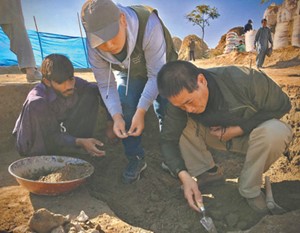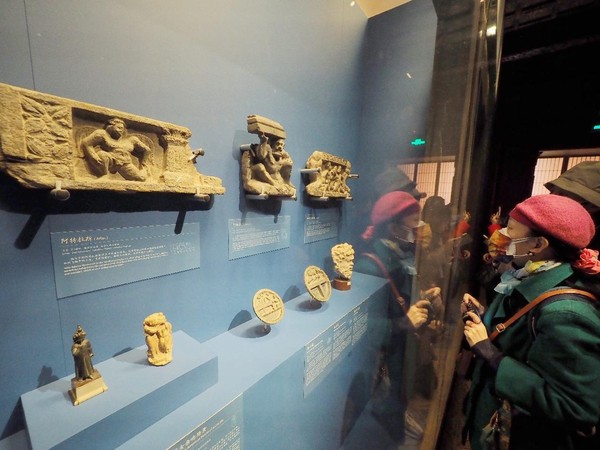By Zhang Danhua, Du Yifei, People's Daily
As an important cradle of human civilizations, Asia has nurtured and is home to an immeasurable wealth of cultural heritage, writing a splendid chapter in the annals of world civilizations.
However, natural disasters, such as earthquakes, as well as climate change, urbanization, regional conflicts, capital and human resource shortage, and insufficient management have placed Asia's conservation of cultural heritage in an unprecedentedly complex situation.

In May 2019, Chinese President Xi Jinping proposed for making efforts to conserve cultural heritage in Asia at the Conference on Dialogue of Asian Civilizations, saying China is ready to work with other countries to protect Asian cultural heritage and better preserve and sustain Asian civilizations.
Now four years on, all parties have made active response and concerted efforts, carried out practical cooperation in the fields of research on ancient civilizations, joint archaeology, relics repair, exchanges between museums and more, and thus Asia has made new contribution to conserving the essence of human civilizations.

Last month, the first General Assembly of the Alliance for Cultural Heritage in Asia was held in Xi'an, northwest China's Shaanxi province. It was joined by 150 representatives from three international organizations and 21 countries including Pakistan.
At the assembly, the Alliance for Cultural Heritage in Asia was officially launched and a joint declaration on cultural heritage protection in Asia released.
According to the declaration, parties involved should carry out wide cooperation on promoting urban and rural cultural heritage conservation, joint archaeology, relics repair, combating illicit trafficking of cultural property, development of cultural heritage conservation technologies and training of young talents, based on the principles of mutual respect, equality, inclusiveness, opening and mutual learning.

Since Xi proposed for making efforts to conserve cultural heritage in Asia in 2019, China and other Asian countries have implemented a series of projects of the cooperation on cultural heritage conservation.
For instance, Art Exhibitions China has hosted the "Three Kingdoms Unveiling the Story" exhibition in Japan; The Palace Museum, in cooperation with relevant departments in Pakistan, has launched the "Gandgara Heritage along the Silk Road" exhibition in the Forbidden City.
Besides, Chinese professionals of archaeology and relics repair have participated in joint archaeology and conservation activities in different countries and regions in Asia. China has signed cooperation documents on cultural heritage conservation with Pakistan and South Korea, and launched senior online training programs on the conservation of stone relics together with Afghanistan and Pakistan.
Nasir Khan, Deputy head of the Department of Archaeology and Museums of the National Heritage and Culture Division of Pakistan, noted that China has always helped Pakistan train professionals and shared with the latter its technological experiences of cultural relics conservation. China has offered opportunities for Pakistani professionals of cultural relics conservation to host exhibitions in China, which is conducive to introducing Pakistani culture to a larger group of audience.
At present, the "Gandgara Heritage along the Silk Road" exhibition is currently held at the Palace Museum in Beijing. Fareena Mazhar, Secretary of the National Heritage and Culture Division of Pakistan, called the exhibition an achievement of the joint efforts made by China and Pakistan.
She said the exhibition is a great outcome of China-Pakistan cultural exchanges and has received wide attention.
According to statistics, China has launched 11 relics repair projects in cooperation with Cambodia, Mongolia, Uzbekistan, Nepal, Myanmar and Kyrgyzstan over the past four years.
Besides, China has also carried out 33 joint archaeological projects with 19 countries including the United Arab Emirates, Uzbekistan and Saudi Arabia, which involved the studies of major civilization routes and systems such as the land and maritime Silk Road.
China has always been active, practical, open and professional in advancing the shared mission of cultural heritage protection in Asia, and has launched wide and effective cooperation with other Asian countries, said Li Qun, vice minister of culture and tourism and head of the National Cultural Heritage Administration.
China will share relevant technologies with other countries and offer technological services in cultural heritage protection for members of the Alliance for Cultural Heritage in Asia in relics conservation and repair, joint archaeology, safety of heritage sites and other sectors.
Besides, China will provide training sessions for at least 50 cultural heritage workers from other Asian countries over the next three years, promote exchanges on technologies, philosophies and practices of cultural heritage conservation in Asia and build young professional teams of Asian cultural heritage protection.

